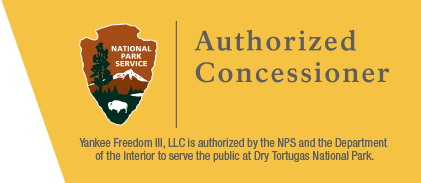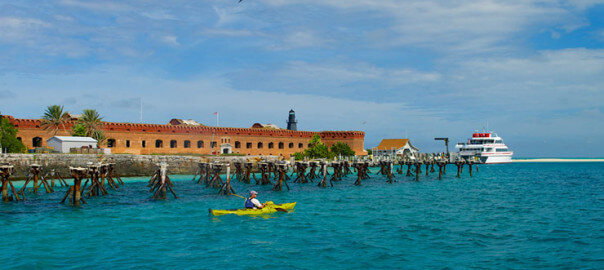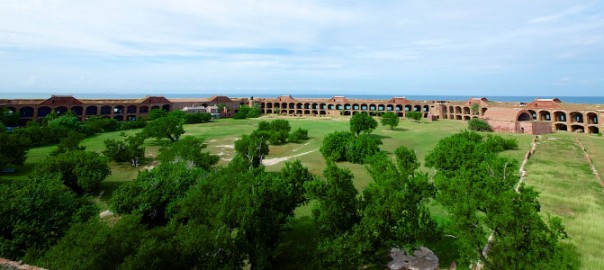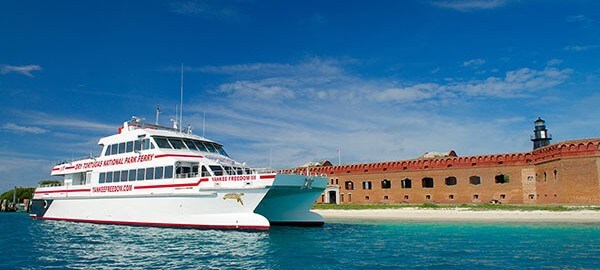The Curious History Of Dry Tortugas National Park
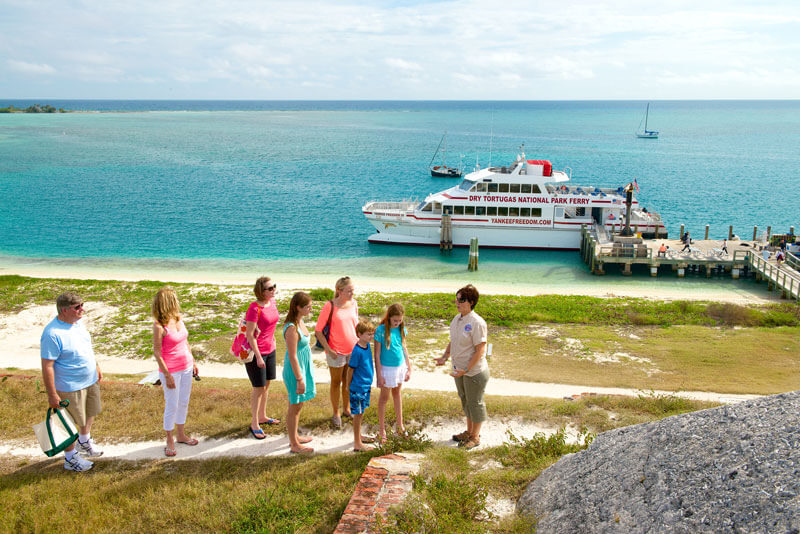
Daniel Dustin
“His stories were what frightened people worst of all. Dreadful stories they were — about hanging, and walking the plank, and storms at sea, and the Dry Tortugas” … — Robert Louis Stevenson, Treasure Island
We are standing on the bow of the Yankee Freedom, a 110-foot catamaran, knifing through the aquamarine waters off Key West, Fla. Ahead of us, on the horizon, are the Marquesas Islands, where Ernest Hemingway often fished. Beyond them, 55 feet below the water’s surface, sits the Nuestra Senora de Atocha, a sunken 17th-century Spanish galleon that only recently relinquished its $400 million treasure to modern-day pirates. Dolphins join us alongside for a few seconds, as do sea turtles and flying fish, but the catamaran’s speed is a formidable 25 knots, and we soon leave everything, including the sight of land, behind us.
The sense of adventure is palpable. As the catamaran’s twin hulls slice through the water, it feels as if we are racing into the past. Like ancient mariners, we scan the horizon, straining our eyes for the first sign of land. Two and one-half hours out of Key West, several forms gradually begin to take shape on the horizon.
“Can you see them?”
“No. Where? I can’t see anything. Wait a minute. Yes, yes, I see them now! They must be the ones!”
The Dry Tortugas
In 1513, when Spanish explorer Ponce de Leon stumbled upon these very islands at the southernmost entrance to the Gulf of Mexico, he was struck by the abundance of sea turtles. He promptly named the islands Las Tortugas (the turtles). Years later the appellation “dry” was added to warn others of the islands’ lack of fresh water. Enchanting as they were from a distance, once ashore it soon became apparent that the islands were unfit for human habitation.
Nonetheless, the strategic significance of the Dry Tortugas was recognized early in our nation’s history. The shipping lane through the Gulf of Mexico was confined to a narrow stream of deep water passing within cannonshot of the islands. Whoever controlled the Dry Tortugas also controlled the passage to and from America’s heartland. Sharpened by fresh memories of the War of 1812, the implications were of no small consequence to the federal government.
Orders were given to begin constructing Fort Jefferson in the Dry Tortugas in 1846. A hexagonal Union fort built using slave laborers, Fort Jefferson remains one of the largest masonry structures in the Western Hemisphere. Taking up the entire 16-acre Garden Key, one of seven islands constituting the Dry Tortugas, the fort was fashioned out of 16 million bricks imported from the continental United States. In the middle of construction, the Civil War broke out, and building materials were increasingly hard to come by. A visible line in the fort’s wall, formed by the use of different-colored bricks from New England, marks the beginning of the Civil War.
Although the 1,500 troops garrisoned at Fort Jefferson never had to defend it in battle, the fort did gain fame during the Civil War as a prison for Union deserters and other undesirables. Dubbed “America’s Devil’s Island,” its most notorious inmate was Dr. Samuel Mudd, exiled for life to the Dry Tortugas for setting the broken leg of John Wilkes Booth, the assassin of President Lincoln. Mudd was eventually pardoned by President Andrew Johnson for his heroic efforts in fighting an outbreak of yellow fever at the fort.
The military abandoned Fort Jefferson in 1874 and it was left to pirates, squatters, and others. In 1898 the U.S.S. Maine sailed from the Dry Tortugas on its ill-fated voyage to the bottom of Havana harbor, helping ignite the Spanish-American War. Ten years later the islands were designated a preserve and breeding ground for birds. Then, in 1935, Fort Jefferson was declared a national monument. President Truman stopped by, as did Queen Elizabeth II, but visitation was generally sparse. Finally, in 1992, Fort Jefferson National Monument was expanded, upgraded, and renamed Dry Tortugas National Park.
The Nascent Park
As one of our newest national parks, we are now committed to protecting the Dry Tortugas in perpetuity. This is no mean feat, for a variety of reasons. First, the park encompasses approximately 100 square miles, only 40 acres of which are above water. It is largely a marine sanctuary that serves as an ecological laboratory for studying, preserving, and enjoying a rich and diversified underwater world.
Patrolling the vast expanse of open water is a tall order — especially for only a handful of park rangers. The importance of doing so, however, is accentuated by the more than 200 sunken ships, dating back to the 1600s, at rest within the park’s boundary. They are of extraordinary historical and cultural significance. The National Park Service does its best to keep the locations of all but two of the wrecks a secret, and metal detectors are prohibited within the park. But the bounty reaped from the Atocha by notorious Key West treasure hunter Mel Fisher several years ago serves as a reminder of the ends to which people will go to dig up antiquities for personal profit.
The Park Service also does its best to keep commercial fishermen from illegally exploiting the fishery, but that, too, is easier said than done. Playing “tag” with commercial vessels that run inside and then outside of the park’s borders makes surveillance and apprehension difficult. To add insult to injury, commercial fishermen frequently take refuge in the park’s safe harbor, and Park Service law enforcement officers are often called upon to mediate disputes between them and other boaters, a burden park officials see as incidental to their primary mission.
In this regard, recreational use of Dry Tortugas National Park has presented few problems to date. The 70 miles of open water separating Key West from the islands have always constrained their recreational use. Despite great fishing, outstanding snorkeling and birding, and fascinating human history, the Dry Tortugas have simply been beyond the reach of most people.
Still, recreational use is accelerating dramatically, and there are clouds over this otherwise cloudless paradise. In 1984, visitation totaled 18,000. Today, visitation is approaching 90,000. Thanks to the national-park status, many tourists from abroad now include the Dry Tortugas, along with the Grand Canyon and Yellowstone, as a must-stop on their visit to the United States. The Internet is also making it easier to spread the word about the new park. In effect, the Dry Tortugas are becoming less and less isolated with each passing day.
What we are witnessing is the embryonic stage of the classic preservation vs. use situation as it has unfolded historically throughout the national parks. The guardians of the Dry Tortugas are charged with preserving their natural and cultural integrity while making the islands available for the public’s use and enjoyment. The predicament is exacerbated by so little land and such delicate life. As Dry Tortugas naturalist Jennifer Naugler implores novice snorkelers to remember, “the coral dies when we touch it.”
A Question of Carrying Capacity
The most pressing task confronting the Park Service in the Dry Tortugas is determining their appropriate recreational carrying capacity. Currently the Park Service is engaged in a visitor use and commercial services planning process, which is intended to produce the number of visitors who can be served by the park without doing irreparable damage to either the park’s resources or to personal experiences.
The problem today is not much different from what Ponce de Leon experienced nearly 500 years ago. The Dry Tortugas are enchanting to visit, enjoy, and appreciate for a short while, but they do not invite staying. Barring the construction of elaborate sewage-disposal and water-purification systems and a dramatic expansion of facilities to accommodate increasing numbers of visitors, Dry Tortugas National Park, by its nature, is not well-suited for our species.
At the same time, Dry Tortugas National Park is particularly suitable for a variety of other species. One-third of the world’s loggerhead turtles nests on East Key. Every year between March and September, 100,000 sooty terns congregate on Bush Key for their nesting season. Add into the mix brown noddies, masked and brown boobies, roseate terns, double-crested cormorants, brown pelicans, and frigate birds, and you begin to understand why the Dry Tortugas are highly valued as a residential community for a wide variety of species.
Indeed, this may be the greatest treasure of all in the Dry Tortugas. Ecologically speaking, they are pristine. The marine environment serves a wonderful social and scientific function just as it is. In a social sense, its untrammeled state reminds us of the limits of human exploitation. Leaving it alone would be an act of restraint and humility. In a scientific sense, its natural condition serves as an important ecological baseline for making comparisons with other ecosystems feeling the increasing impact of human-induced changes.
Sailing Away
At 3 p.m., after four hours on Garden Key, including a highly informative tour of Fort Jefferson, a picnic lunch provided by the crew of Yankee Freedom, a stroll around the perimeter of the island, and a delightful few minutes inside the fort observing birders observe birds, it is time to return to Key West. As the catamaran leaves the dock, we work our way once more to the bow, face east, and savor the tropical breeze. Fort Jefferson soon recedes in the distance as do all seven of the Dry Tortugas.
COPYRIGHT 1999 National Recreation and Park Association
COPYRIGHT 2004 Gale Group
